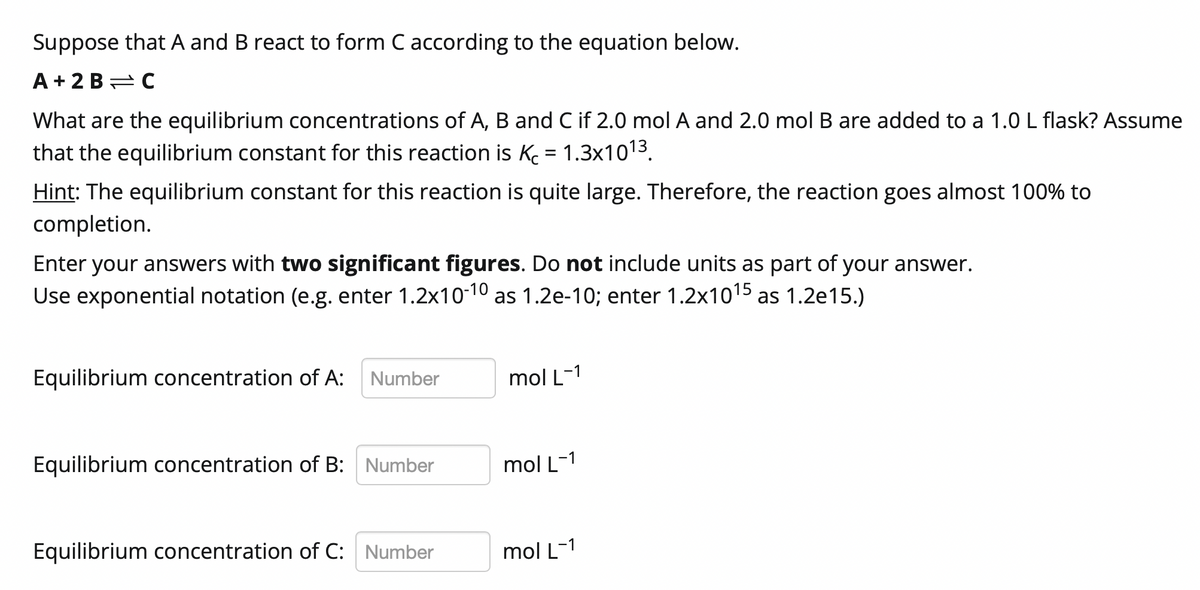Suppose that A and B react to form C according to the equation below. A + 2 B C What are the equilibrium concentrations of A, B and C if 2.0 mol A and 2.0 mol B are added to a 1.0 L flask? Assume that the equilibrium constant for this reaction is Ke = 1.3x1013. Hint: The equilibrium constant for this reaction is quite large. Therefore, the reaction goes almost 100% to completion. Enter your answers with two significant figures. Do not include units as part of your answer. Use exponential notation (e.g. enter 1.2x10-10 as 1.2e-10; enter 1.2x1015 as 1.2e15.) Equilibrium concentration of A: Number mol L |-1 Equilibrium concentration of B: Number mol L-1 Equilibrium concentration of C: Number mol L-1
Suppose that A and B react to form C according to the equation below. A + 2 B C What are the equilibrium concentrations of A, B and C if 2.0 mol A and 2.0 mol B are added to a 1.0 L flask? Assume that the equilibrium constant for this reaction is Ke = 1.3x1013. Hint: The equilibrium constant for this reaction is quite large. Therefore, the reaction goes almost 100% to completion. Enter your answers with two significant figures. Do not include units as part of your answer. Use exponential notation (e.g. enter 1.2x10-10 as 1.2e-10; enter 1.2x1015 as 1.2e15.) Equilibrium concentration of A: Number mol L |-1 Equilibrium concentration of B: Number mol L-1 Equilibrium concentration of C: Number mol L-1
Chemistry: Principles and Practice
3rd Edition
ISBN:9780534420123
Author:Daniel L. Reger, Scott R. Goode, David W. Ball, Edward Mercer
Publisher:Daniel L. Reger, Scott R. Goode, David W. Ball, Edward Mercer
Chapter14: Chemical Equilibrium
Section: Chapter Questions
Problem 14.40QE
Related questions
Question
2

Transcribed Image Text:Suppose that A and B react to form C according to the equation below.
A + 2 B= C
What are the equilibrium concentrations of A, B and C if 2.0 mol A and 2.0 mol B are added to a 1.0 L flask? Assume
that the equilibrium constant for this reaction is K = 1.3x1013.
Hint: The equilibrium constant for this reaction is quite large. Therefore, the reaction goes almost 100% to
completion.
Enter your answers with two significant figures. Do not include units as part of your answer.
Use exponential notation (e.g. enter 1.2x10-10 as 1.2e-10; enter 1.2x1015 as 1.2e15.)
Equilibrium concentration of A:
Number
mol L-1
Equilibrium concentration of B: Number
mol L-1
Equilibrium concentration of C: Number
mol L-1
Expert Solution
This question has been solved!
Explore an expertly crafted, step-by-step solution for a thorough understanding of key concepts.
Step by step
Solved in 2 steps with 2 images

Knowledge Booster
Learn more about
Need a deep-dive on the concept behind this application? Look no further. Learn more about this topic, chemistry and related others by exploring similar questions and additional content below.Recommended textbooks for you

Chemistry: Principles and Practice
Chemistry
ISBN:
9780534420123
Author:
Daniel L. Reger, Scott R. Goode, David W. Ball, Edward Mercer
Publisher:
Cengage Learning

Chemistry: The Molecular Science
Chemistry
ISBN:
9781285199047
Author:
John W. Moore, Conrad L. Stanitski
Publisher:
Cengage Learning

Chemistry for Engineering Students
Chemistry
ISBN:
9781337398909
Author:
Lawrence S. Brown, Tom Holme
Publisher:
Cengage Learning

Chemistry: Principles and Practice
Chemistry
ISBN:
9780534420123
Author:
Daniel L. Reger, Scott R. Goode, David W. Ball, Edward Mercer
Publisher:
Cengage Learning

Chemistry: The Molecular Science
Chemistry
ISBN:
9781285199047
Author:
John W. Moore, Conrad L. Stanitski
Publisher:
Cengage Learning

Chemistry for Engineering Students
Chemistry
ISBN:
9781337398909
Author:
Lawrence S. Brown, Tom Holme
Publisher:
Cengage Learning


Chemistry
Chemistry
ISBN:
9781305957404
Author:
Steven S. Zumdahl, Susan A. Zumdahl, Donald J. DeCoste
Publisher:
Cengage Learning

Chemistry: An Atoms First Approach
Chemistry
ISBN:
9781305079243
Author:
Steven S. Zumdahl, Susan A. Zumdahl
Publisher:
Cengage Learning